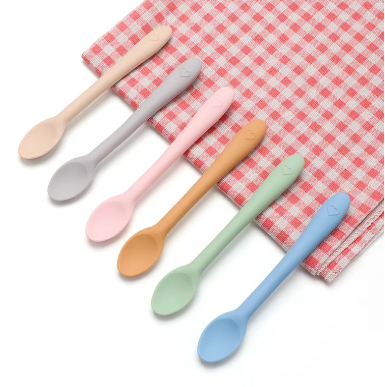Essential Cleaning Techniques for Silicone Utensils
Daily Cleaning: Handwashing vs. Dishwasher Safety
When it comes to cleaning silicone utensils, handwashing tends to preserve their integrity better than using a dishwasher. Although dishwashers provide convenience, the high heat can compromise the longevity of silicone materials if they are not placed correctly or run on an improper cycle. Studies have shown that continuous exposure to high temperatures in dishwashers can lead to earlier signs of wear in silicone Products. For handwashing, it is beneficial to use gentle dish soap and water, avoiding abrasive scrubbing tools that may damage the silicone surface. This method not only cleans effectively but also extends the life of your utensils.
Choosing Safe Detergents to Avoid Chemical Damage
Selecting the right detergent is crucial to avoid chemical damage to silicone utensils. It's best to opt for non-toxic, fragrance-free cleaning products that minimize harmful interactions with the silicone. Ingredients such as bleach and strong alkaline cleaners should be avoided as they can degrade the silicone's material, leading to brittleness or discoloration. Health experts suggest using eco-friendly alternatives like plant-based cleaners for kitchen utensils to ensure safety and longevity. Not only does this approach protect the utensils, but it also contributes to a healthier environment in the kitchen.
Proper Drying Methods to Prevent Moisture Buildup
Moisture buildup in silicone utensils can lead to the growth of mildew and bacteria, affecting both hygiene and usability. Proper drying techniques are critical in maintaining the quality and safety of these kitchen tools. Air drying on a rack is preferable, as it ensures thorough ventilation and discourages moisture retention. Alternatively, wiping silicone utensils with a lint-free cloth can be effective in absorbing excess water. Health organizations emphasize that maintaining dry kitchenware is essential for hygiene, as damp surfaces can become breeding grounds for microorganisms.
Heat Resistance and Safe Usage Guidelines
Understanding Temperature Limits for Silicone Durability
Silicone utensils are prized for their high heat resistance, but understanding their temperature limits is crucial for maintaining durability. Typically, silicone can endure temperatures up to 500°F (260°C), making it ideal for kitchen applications. However, it's essential not to exceed this range, as extreme heat can degrade its structure. For instance, prolonged exposure to heat above 500°F can cause silicone to warp or even melt. According to manufacturers, maintaining usage below these critical temperatures ensures longevity and functionality. It's advised to consult product guidelines like those provided by top brands to ensure adherence to safe usage standards.
Avoiding Thermal Shock: Managing Sudden Temperature Changes
Thermal shock is a concern for silicone utensils, as abrupt temperature changes can compromise their integrity. This phenomenon occurs when hot utensils are suddenly introduced to cold environments, such as placing a warm silicone dish directly into cold water. To mitigate thermal shock, it’s recommended to gradually adjust the temperature transitions, allowing the silicone to adapt slowly. For instance, placing hot items on a room-temperature surface can prevent immediate cooling. Reliable studies emphasize treating food-grade silicone with care to preserve its properties, ensuring safe temperature handling during culinary practices. Integrating these practices can protect and prolong the lifespan of silicone kitchenware.
Proper Storage Solutions to Prevent Deformation
Hanging vs. Drawer Storage: Best Practices
When it comes to storing silicone utensils, choosing between hanging them or placing them in drawers is crucial for maintaining their longevity and functionality. Hanging storage offers distinct advantages, such as better airflow around the utensils, which minimizes moisture accumulation and potential deformation. Hanging utensils on hooks or racks also makes them easily accessible and can save space in a crowded kitchen. However, hanging might not be suitable for more of the compact kitchen settings where drawer space is more abundant.
Conversely, storing utensils in drawers provides a tidy and organized appearance but can lead to issues if not done properly. If not stored correctly, utensils might pile up, causing pressure and bending over time. To mitigate this, using drawer dividers or soft organizers can help maintain an even distribution of weight and prevent utensils from pressing against each other. This ensures that your silicone tools remain in shape and ready for use when needed.
Avoiding Pressure Points for Long-Term Shape Retention
Prolonged exposure to pressure is detrimental to the shape retention of silicone utensils. The pliable nature of silicone can easily succumb to deforming pressures, leading to permanent warping if stored incorrectly. According to material studies, silicone loses its elasticity when it is stored under continuous weight or pressure, emphasizing the need for careful organization.
To avoid these pressure points, consider using soft dividers or trays that gently cradle each utensil, ensuring no undue stress is placed on any part. Common mistakes include stuffing utensils into small drawers or placing heavy items on top, a practice that experts strongly advise against. By keeping these tips in mind, you can safeguard your silicone utensils from deforming and extend their usability, making your kitchen more efficient and enjoyable.
Stain and Odor Removal Strategies
Baking Soda and Vinegar Solutions for Stubborn Stains
Baking soda and vinegar are a dynamic duo in the realm of natural cleaners, particularly effective for silicone stain removal. The basic chemistry involves baking soda, a weak base, reacting with vinegar, an acid, to form a fizzy solution that breaks down stains. A typical mixture might include one tablespoon of baking soda with one teaspoon of vinegar, applied to the stained area and scrubbed gently. Users have found this combination potent against tough kitchen stains, and anecdotes frequently highlight its efficiency without the harshness of commercial chemicals. Moreover, opting for these natural remedies supports an eco-friendly cleaning approach, reducing reliance on chemical cleaners and minimizing environmental pollution.
Sunlight and Lemon Techniques for Odor Elimination
Sunlight and lemon juice are powerful agents in neutralizing odors on silicone utensils, providing a refreshingly clean scent without chemical residues. The ultraviolet rays in sunlight help break down odor molecules, while the citric acid in lemon juice acts as a natural disinfectant. To apply the method, coat the utensils in lemon juice and leave them under direct sunlight for a couple of hours. Cleaning experts attest to the effectiveness of this simple, yet ingenious technique, which not only refreshes your kitchen tools but also promotes a healthier indoor environment by reducing exposure to synthetic fragrances found in many commercial deodorizers. This method aligns with eco-conscious practices, ensuring a hygienic kitchen space while safeguarding health and the planet.
Troubleshooting Common Silicone Utensil Issues
Addressing Discoloration from Food Pigments
Discoloration in silicone utensils is a prevalent issue caused by food pigments. These pigments, found particularly in deeply colored foods like tomato sauce, turmeric, and beets, can penetrate the silicone surface, leading to unsightly stains over time. According to chemical studies, these pigments bind with the silicone material at a molecular level, making it challenging to remove them solely with water and detergent. To treat or prevent discoloration, washing utensils immediately after use can minimize pigment absorption. Remedies like baking soda paste or white vinegar can also help lift stains. Expert opinion highlights maintaining a clear, vibrant look by using lighter-colored silicone utensils for foods with high staining potential.
Preventing Mold Growth in High-Humidity Environments
High humidity levels can significantly contribute to mold growth on silicone utensils. Data from health studies indicate that prolonged exposure to moisture creates an ideal breeding ground for mold, posing health risks such as respiratory issues. To combat this, practical measures include storing utensils in a dry, well-ventilated area and ensuring they are completely dry after washing. A study from the Journal of Environmental Health recommends silica gel packs within utensil storage areas to absorb excess moisture. For environments with persistent humidity issues, consider sealed storage containers with moisture control features to protect your silicone utensils from mold growth.
FAQ Section
How should I clean silicone utensils daily?
For daily cleaning, handwashing with gentle dish soap and water is recommended over using a dishwasher to extend the life of silicone utensils.
What detergents are safe to use for silicone utensils?
Non-toxic, fragrance-free cleaning products are best to avoid chemical damage. Avoid bleach and strong alkaline cleaners.
At what temperature can silicone utensils be safely used?
Silicone utensils are typically safe up to 500°F (260°C). Exceeding this can degrade their structure.
How can I prevent mold on silicone utensils in humid environments?
Ensuring utensils are completely dry after washing and stored in a well-ventilated area can help prevent mold growth. Using silica gel packs can also be beneficial.


